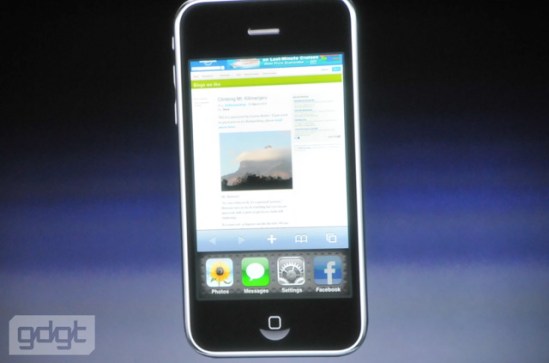
Steve Jobs announced in a press event today that the iPhone will finally receive multitasking capabilities in version 4.0 of the iPhone operating system — which is due to hit sometime this summer. Since the iPad also runs the iPhone OS, this means that it will be receiving multitasking as well.
[aditude-amp id="flyingcarpet" targeting='{"env":"staging","page_type":"article","post_id":174604,"post_type":"story","post_chan":"none","tags":null,"ai":false,"category":"none","all_categories":"business,mobile,","session":"A"}']We previously speculated that multitasking — the ability to run third-party iPhone applications in the background — would be a major announcement at today’s Apple event, and Jobs didn’t disappoint. According to GDGT’s live coverage of the event, he prefaced the announcement by saying:
We weren’t the first to this party, but we’re going to be the best. Like cut and paste — it’s better than any other implementation. It’s really easy to implement it in a way that really drains battery life. And, it’s really easy to implement it in a way that reduces the performance of the foreground app and makes your phone feel sluggish.
In true Apple fashion, the multitasking interface that Jobs demonstrated looked simple and easy to use. When inside any application in iPhone OS 4.0, you just need to double-tap on the home screen to bring up a list of applications currently running. Jobs was able to seamlessly move between a game (Tap Tap Revenge), an eBay app, his mail, and a web browser without much fuss.
AI Weekly
The must-read newsletter for AI and Big Data industry written by Khari Johnson, Kyle Wiggers, and Seth Colaner.
Included with VentureBeat Insider and VentureBeat VIP memberships.
Jobs then turned the stage over to Scott Forstall, senior VP of iPhone software, who went on to list seven multitasking services that would be available to app developers:
- Background audio streaming: Allows you to run music apps like Pandora in the background. The Pandora app will also be integrated into the playback controls on the iPhone’s lock screen.
- Voice over IP (VoIP): Lets apps like Skype receive calls even while your iPhone is locked.
- Background location: Gives turn-by-turn navigation apps like TomTom the ability to know your location when you’re not in the app and gives location-based services like Loopt the ability to track your location using cell tower-based positioning.
Since standard GPS uses a lot of power, Apple suggests that it’s something best used in the car. Cell tower-based positioning doesn’t require as much power. An arrow indicator in the status bar will tell you if an app is tracking your location, and you can also enabled and disable the feature on a per-application basis. - Push notifications: These are the standard notifications we’ve grown to love and hate on the iPhone. The iPhone has had push notifications for about 9 months, and in that time over 10 billion push notifications were sent.
- Local notifications: Similar to push notifications, except they don’t require a server and are driven by the phone. I suspect this will be a particularly useful addition.
- Task completion: Allows apps to continue working when you navigate away. For example, you’ll be able to continue loading a photo through the Flickr app while doing something else.
- Fast app switching: Allows apps to instantly store state data and use no resources when you navigate away. It’s basically the appearance of multitasking without using any system resources (other than the space required to store the state data).
While this multitasking implementation is a big step for Apple, it’s still technically not true multitasking, since apps can’t remain fully functional in the background. As Jobs mentioned, Apple’s main concern was implementing multitasking without sacrificing battery life or system performance — so it makes sense for the company to be a lot particular.
I’d instead call it “smart” multitasking, since it allows specific functions in applications to run in the background. The fast app switching feature will make it appear as if the apps always remained running in the background, so some users may not ever notice the lack of full multitasking.
Jobs also announced that multitasking would only be available for the iPhone 3GS, third-generation iPod Touch (released last fall), and the iPad. The iPad will receive the OS 4.0 update in the fall, while the iPhone will get it sometime in the summer. The iPhone 3G and earlier iPod Touch models simply don’t have the hardware to support the feature, but that’s no great surprise.
I suspect that there are still many iPhone OS 4.0 features that haven’t been announced yet — in particular, those that will rely on new hardware in the next-generation iPhone. So if you were hoping to see Apple introduce video conferencing into the OS, I suggest waiting until this summer before you give up entirely.
[aditude-amp id="medium1" targeting='{"env":"staging","page_type":"article","post_id":174604,"post_type":"story","post_chan":"none","tags":null,"ai":false,"category":"none","all_categories":"business,mobile,","session":"A"}']
[Images via GDGT]
VentureBeat's mission is to be a digital town square for technical decision-makers to gain knowledge about transformative enterprise technology and transact. Learn More
